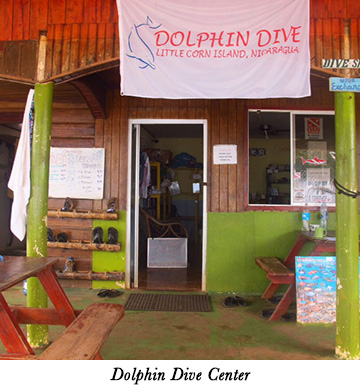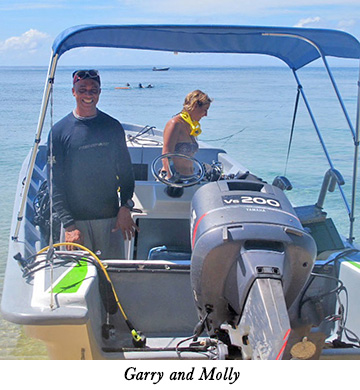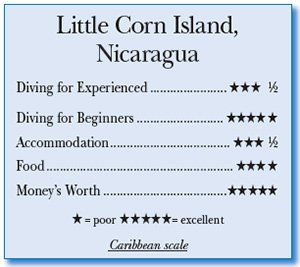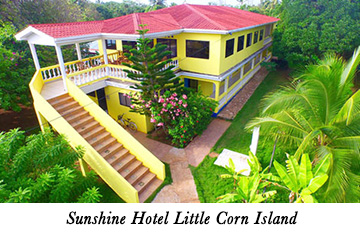Little Corn Island, NicaraguaContents of this Issue: Nautilus Belle Amie, Guadalupe Island, Mexico Rigid Rules for Flying with Lithium Batteries Stay Away from that Propeller! Would You Opt For In-Water Recompression? Hyperbaric Help Might Not Be Close At Hand in Florida Book Review: Secrets of the Seas Sri Lanka Aggressor Cancels Early Trips Judge Rules in Deceased Diverís Familyís Favor Book Review: Shark Doc, Shark Lab A Legal Opinion on Liability Waivers Six Deaths in Five Days Call for Tougher Aussie Standards Those Little Blue Pills Offer Risk to Male Divers How You Use Your Tank Valve May Be Wrong: The Quarter Turn That Can Kill NEW! Want a Printed Copy at 50% Off? Editorial Office: Ben Davison Publisher and Editor Undercurrent 3020 Bridgeway, Suite 102 Sausalito, CA 94965 the Caribbean of yesteryear from the January, 2017 issue of Undercurrent
I wasn't sure what to expect, though I had read a ten-year-old Undercurrent article that suggested a diver might be bored after a few days. I certainly wasn't. While this is surely standard Caribbean diving, it's far from the madding crowd, with unspoiled, unbleached reefs. After six days of diving, I would have welcomed more. Perhaps a unique diving feature is the ubiquitous and gregarious nurse sharks. On my first dive at Jeff's Rock, the ocean was bumpy and visibility about 60 feet (18m) or less. Soon after I hit the water, I was approached by a curious fivefoot nurse shark that followed us around for most of the dive (hmm, like he was looking for a handout, but my shop did no feeding). Among the reefs and small canyons, I came across two others, as well as a good-sized western stingray, plenty of tropicals, but not in large numbers. The depths ran 50-80 feet (15-25m), and water a constant 84°F (29°C) in November. Our afternoon dive was at White Holes, maybe no deeper than 30 feet (9m), but 80-foot-plus visibility. Unlike so much of the depleted Caribbean, here were stands of magnificent staghorn and elkhorn corals among the large sand patches. An eagle ray winged past, several 5- to 6-foot (2m) nurse sharks lolled about, western stingrays lay in the sand, and typical reef fish swayed to and fro in the modest surge. And after that dive, I did what I came to do every day -- go to Habanas, between the dive shop and our hotel, to devour a delicious ham and cheese sandwich or fish sandwich on coconut bread, served up by the Cuban owner. To get to Little Corn, I had to spend the first night on Big Corn -- that's where the airport is -- and took a one buck/person taxi to our guest house, Comedor Maris Danet's, where $9 bought a full lobster dinner. Next morning, another taxi ride to the wharf to catch the panga ($6) to Little Corn. It was a wet and wild ride (if the ocean is too rough, it doesn't go), and I wish I had had a garbage bag to cover my stuff. I had made advanced reservations at the 20-plus-room, air-conditioned, cinderblock Sunshine Hotel, parked amidst beautiful, manicured gardens. The $55/ night room -- reasonably sized, comfortable, plenty of warm water -- included a simple but classic Nicaraguan breakfast -- scrambled eggs on a tortilla with rice and beans and plantains and real coffee (most places, it's Nescafe) -- and a five-percent discount with Dolphin Dives, less than a five-minute walk. For three days, no alcohol was served anywhere on the island -- that's the rule during national elections -- so the friendly proprietors brought plenty of ice cubes for the bottle of spirits I had brought. In the hotel was the only (mini) "farmica" on the island, and several rustic piquant eateries were nearby.
To travel light, I brought only my Canon G12 in an Ikelite case, no strobe, my Suunto "zoot" wrist computer, a mask and snorkel. At no charge, Dolphin supplied the rest -- their regulators and BCs were well maintained -- including a wet suit. The gear was included in their dirt-cheap price of $65 for two tanks (though dives were short -- about 45 minutes -- and some folks ran out of air sooner). Besides two morning tanks, they offer afternoon and night dives. I regularly dived with three others -- Canadians and an Egyptian -- and local Garry Sjogreen, the divemaster, so we stayed down longer, especially on the shallower dives. One day, another divemaster, Molly (she's from Holland), had a group of novices, and, to be kind, challenged divers. While my group had a fine dive, two of her divers quickly ran out of air, another got sick, and they all surfaced way early. I was impressed how well she handled them and their inexperience.
We dived Suenos on a calm day, the ocean a pellucid blue-green, with visibility well over 150 feet (46m). Several large reef sharks cruised by, keeping their distance, unlike their nurse shark cousins, as did a cruising eagle ray. A hawksbill turtle flitted along the reef, parrotfish nibbled at the coral -- it was the only time I saw parrot fish -- while triggerfish went about their business. And here, a stunning site, a huge Goliath grouper the size of a wine barrel came so close I could have chucked his chin, but I resisted. As I learned, where the boat goes is weather-dependent. I was disappointed not to get to Tarpon Channel on the north side, where hammerheads are said to congregate, and not to Blowing Rock, a seamount an hour away, closer to Big Corn. A few days, I did some free diving on the north side. Snorkeling required a bit of a swim, so one would be better off snorkeling from the dive boat.
But they served up lobster and fish dinner for under 10 bucks. With a cold beer and frequent chats with passing locals - they're largely Garifuna, and everyone speaks both English and Spanish -- who were happy to share their life stories, it was great fun. Surely, this is the old Caribbean, with no mail service, no bank, no ATM, minimally reliable phone, internet and electrical service, and no doctors. There is one upscale bar/restaurants where the youthful backpackers hang out, and while lodging is mostly simple and inexpensive, a yoga retreat extracts $400/night from its guests. The diving is good, but not fantastic; you will see better coral reefs in Bonaire, for example, but nowhere near as many sharks. Nonetheless, if you like a low-key, uncrowded environment, with small groups of divers, like to mix with the locals, meet new friends of diverse cultures, and enjoy the tasty haute cuisine of fresh, local seafood daily, Little Corn can be a journey's end. -- M.A. Our undercover diver's bio: I started free diving for abalone and spearfishing in Northern California in the late 70s. In the 80s, while on my honeymoon at an all inclusive resort, I was very bored -- not with my wife, but with the activities -- so I got certified and found that as a free diver I enjoyed actually staying underwater. I took a real class back to the States and have logged more than a thousand dives. Currently, I volunteer with Reef Check in Monterey, California, and take a couple warm water vacations each year.
|

I want to get all the stories! Tell me how I can become an Undercurrent Online Member and get online access to all the articles of Undercurrent as well as thousands of first hand reports on dive operations world-wide
| Home | Online Members Area | My Account |
Login
|
Join
|
| Travel Index |
Dive Resort & Liveaboard Reviews
|
Featured Reports
|
Recent
Issues
|
Back Issues
|
|
Dive Gear
Index
|
Health/Safety Index
|
Environment & Misc.
Index
|
Seasonal Planner
|
Blogs
|
Free Articles
|
Book Picks
|
News
|
|
Special Offers
|
RSS
|
FAQ
|
About Us
|
Contact Us
|
Links
|
3020 Bridgeway, Ste 102, Sausalito, Ca 94965
All rights reserved.

 Not many divers visit the Corn Islands, one
reason being that they've never heard of these
little Caribbean isles, about 50 miles off the
Nicaragua coast. Little Corn is about 1.5 square
miles, with no cars, motorcycles or even golf
carts, but full of amiable folks, good shallow
reef diving, diverse cuisine, and lots of
charm. Entirely without glitter or much of a
tourist infrastructure, it's my kind of place.
So, thanks to an invitation to a Nicaraguan wedding,
I toured the fine colonial cities of Leon
and Granada, which is bordered by the imposing
Lake Nicaragua, and did some spearfishing in the
Pacific. Then, I grabbed a flight from Managua
for eight days on Corn Island.
Not many divers visit the Corn Islands, one
reason being that they've never heard of these
little Caribbean isles, about 50 miles off the
Nicaragua coast. Little Corn is about 1.5 square
miles, with no cars, motorcycles or even golf
carts, but full of amiable folks, good shallow
reef diving, diverse cuisine, and lots of
charm. Entirely without glitter or much of a
tourist infrastructure, it's my kind of place.
So, thanks to an invitation to a Nicaraguan wedding,
I toured the fine colonial cities of Leon
and Granada, which is bordered by the imposing
Lake Nicaragua, and did some spearfishing in the
Pacific. Then, I grabbed a flight from Managua
for eight days on Corn Island. Before flying to Corn, the weather looked bad, so I called Dolphin Dive's
proprietor, Adam Clarke (he's from the UK), to make sure they'd be diving. "Of
course," he said, "we have great conditions, a little wind and bump, but all is
fine." As I learned, unless there are pre-hurricane conditions, they'll head out
in their small (about 18-foot,/5.5m) open boats, which may carry as many as 10
divers, with no room for big camera rigs. (The sites were only five to ten minutes
away). The boats, loaded and ready to go, launch from the beach. Upon return, you
tote your gear to the shop, about 50 feet (15m) away.
Before flying to Corn, the weather looked bad, so I called Dolphin Dive's
proprietor, Adam Clarke (he's from the UK), to make sure they'd be diving. "Of
course," he said, "we have great conditions, a little wind and bump, but all is
fine." As I learned, unless there are pre-hurricane conditions, they'll head out
in their small (about 18-foot,/5.5m) open boats, which may carry as many as 10
divers, with no room for big camera rigs. (The sites were only five to ten minutes
away). The boats, loaded and ready to go, launch from the beach. Upon return, you
tote your gear to the shop, about 50 feet (15m) away. Yellow Tail, a reef with a few swim-thrus, and even dolphins when we first hit
the water, provided more nurse sharks and a close encounter with a pair of fourfoot
barracuda, as well as eagle rays, triggers, and, briefly, far too briefly,
a toad fish. You see, Garry wanted other divers to see the toadfish, and as he
was pointing it out, a nurse shark swam over, stuck his head in the crevice, and
abruptly devoured the poor toadfish.
Yellow Tail, a reef with a few swim-thrus, and even dolphins when we first hit
the water, provided more nurse sharks and a close encounter with a pair of fourfoot
barracuda, as well as eagle rays, triggers, and, briefly, far too briefly,
a toad fish. You see, Garry wanted other divers to see the toadfish, and as he
was pointing it out, a nurse shark swam over, stuck his head in the crevice, and
abruptly devoured the poor toadfish. The easy access, clear water, minimal currents and healthy flora and fauna
made Little Corn a nice dive destination. I enjoyed the "island vibe" and delicious
eateries, which are little more than a few chairs outside people's houses on
the main street -- frankly it's more like a trail, sometimes paved, sometimes not.
The easy access, clear water, minimal currents and healthy flora and fauna
made Little Corn a nice dive destination. I enjoyed the "island vibe" and delicious
eateries, which are little more than a few chairs outside people's houses on
the main street -- frankly it's more like a trail, sometimes paved, sometimes not. Divers Compass: La Costena flights from Managua to Corn were
$184 RT. There is 30-pound limit on checked luggage, so additional
bags may arrive the day after you do, especially during busy
season (December to May) ... To avoid online booking fees ($18/
ticket), call La Costena in Managua airport (505) 2298 5360 ...
We had no bug problems, but the Zika virus and dengue fever
appear in Nicaragua ... Since there is limited night lighting
and power can go out, bring a flashlight (I brought an LED headlamp)
... A 10-dive package runs $280, plus a 5% discount from the hotel ... Check for recommended vaccines at:
Divers Compass: La Costena flights from Managua to Corn were
$184 RT. There is 30-pound limit on checked luggage, so additional
bags may arrive the day after you do, especially during busy
season (December to May) ... To avoid online booking fees ($18/
ticket), call La Costena in Managua airport (505) 2298 5360 ...
We had no bug problems, but the Zika virus and dengue fever
appear in Nicaragua ... Since there is limited night lighting
and power can go out, bring a flashlight (I brought an LED headlamp)
... A 10-dive package runs $280, plus a 5% discount from the hotel ... Check for recommended vaccines at: 